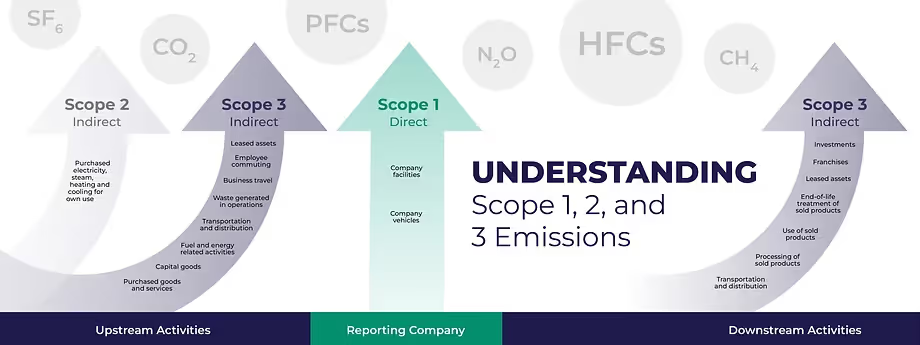
Solutions
Carbon Management
ESG Intelligence
Climate & Nature Risk
Data Registry
Beta
Sector
Get started, schedule a demo or request a free assessment!


In the journey to being sustainable, it's important to address and effectively manage greenhouse gas (GHG) emissions. The Greenhouse Gas Protocol, a widely recognized global standard for quantifying and reporting GHG emissions, categorizes these emissions into three scopes: Scope 1, Scope 2, and Scope 3. Scope 1 represents direct emissions and Scope 2 and 3 represent indirect emissions that are based on the levels of control your organization has over its emissions such as your own operations, your product lifecycle, supply and value chains, stakeholder and supplier relationships, and all other related activities and provides a framework for understanding, tracking, and reporting these emissions
The term "scope" for emissions comes from the Greenhouse Gas Protocol (GHG Protocol), for quantifying and reporting greenhouse gas (GHG) emissions. The categorization of emissions helps you understand the origination of emissions and are categorized into three scopes:
Managing Scope 1 emissions is fairly straightforward for an organization since these are its direct emissions and are easier to recognize and measure. In essence, they stem directly from activities conducted at the company level and are commonly referred to as direct emissions.
Scope 2 emissions are indirect emissions from the generation of purchased energy, from a utility provider. These emissions occur at the power plant or other source of energy generation but are accounted for by the organization because they are a result of its energy use.
Scope 3 emissions are all other indirect emissions that occur in the value chain of your organization and are not already included within Scope 1 and 2. These emissions are a consequence of the organization's business activities but occur from sources the company does not own or control.
Scope 3 emissions are split into 15 categories and are organized into two types - upstream or downstream emissions in the value chain. This categorization is intended to provide you with a systematic framework to track, measure, and manage emissions across your organization’s value chain.
“Upstream emissions are defined as indirect GHG emissions related to purchased or acquired goods and services.” These are emissions that occur in the production and supply chain of goods and services before they reach the final consumer. An example of upstream emissions is the emissions associated with your employee’s commute to the office. If your company produces paper sources raw materials via road using a logistics service provider, all the emissions associated with the transport of the raw materials from your supplier factory to your company’s factory would be in Scope 3 Category 4 - Upstream Transportation and Distribution. The emissions associated with the raw material bought would be considered under Scope 3 Category 1 - Purchased Goods and Services.
“Downstream emissions are defined as indirect GHG emissions related to sold goods and services.” These are emissions that occur in the usage and disposal process of the product or service your organization provides. For example, if your organization produces computers, the emissions from electricity usage to power the computer, and the emissions from its disposal would be your organization’s Scope 3 Category 10 - Use of sold products and Scope 3 Category 13 - End-of-life treatment of sold products respectively
An indicator of which is an upstream or downstream emission would be one factor: who’s paying for the product or service; if the organization (employees and the company) is paying for it to produce their product/service, it’s likely to be an upstream emission and if the consumer or the client is paying to use or dispose of it, it’s likely to be a downstream emission. While this works as an indicator, we always recommend referring to the GHG Protocol’s Scope 3 Calculation Guidance for specifics.
Scope 3 emissions are by far the toughest to measure. There are also significant challenges faced by organizations due to limited data availability. At StepChange, we work with an organization’s existing data streams and compute Scope 3 emissions for organizations within days using our extensive emission factor database.
StepChange's ESG Software Platform helps streamline the process of tracking Scopes 1, 2, and 3 emissions by working with your existing data streams and providing your organization with a centralized platform to collect, analyze, and report their ESG and Sustainability data. With StepChange's ESG Accelerator platform, you can comprehensively understand your total carbon footprint and make informed decisions to reduce your emissions. StepChange's ESG Software Platform collects data seamlessly via its 350+ integrations which connect directly to an organization’s Enterprise Resource Planning (ERP), Accounting, Human Resource Management System (HRMS), and Customer Relationship Management (CRM) software. StepChange’s ESG Software Platform is also enabled with access-based controls and multiple other features to ensure all the data tracked and entered are accurate and 100% audit-ready.

.svg)